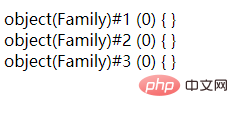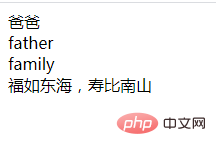
In the previous article, I brought you "Take you to understand the class definition class and member attribute methods in PHP", which introduced in detail the class definition class, member attribute and Basic knowledge related to member methods. In this article, we will continue to learn how to instantiate objects in PHP. I hope it will be helpful to everyone!

Earlier we introduced how to define a class. It is very simple to use a variable and function, but it is very simple to use the attributes and methods in the class. There is one step to take first, that is to instantiate the class first, so let's take a look at it together.
Instantiate objects
If you want to instantiate a class into an object, there is just one more simple step. You need to use the new keyword and add a method with the same name as the class name at the end. Indicates a new object.
It should be noted that when instantiating an object without passing parameters for the object, use the class name directly after the new keyword without adding parentheses.
The syntax format for instantiating objects is as follows:
变量名 = new 类名(参数列表); 或 变量名 = new 类名;
What we need to pay attention to in the syntax format is:
The variable name is the reference name of an object created through the class , you can access the members of this object through this name.
The parameter list is the value used by the constructor of the specified class to initialize the object. If there is no constructor defined in the class, PHP will automatically create a default constructor without parameters.
Next we use an example to see how to instantiate an object. The example is as follows:
<?php
class Family{
}
$father1 = new Family();
$father2 = new Family;
$father3 = new Family;
var_dump($father1);
echo '<br>';
var_dump($father2);
echo '<br>';
var_dump($father3);
?>Output result:

A class can instantiate multiple objects, each object is independent. The above code instantiates three objects through the family class.
Accessing members in an object
The object is composed of member properties and member methods. If you want to access the members of the object, In fact, it is a bit like accessing elements in an array. Since it is a bit similar, to access the members of the object through the reference of the object, you also need to use a special operator -> to complete the access to the members of the object.
Its syntax format is as follows:
变量名 = new 类名(参数); //实例化一个类 变量名 -> 成员属性 = 值; //为成员属性赋值 变量名 -> 成员属性; //直接获取成员属性的值 变量名 -> 成员方法(); //访问对象中的成员方法
The method used is very simple. Let’s take a look at an example:
<?php
class Website{
public $baba, $dad, $title;
public function demo(){
echo '福如东海,寿比南山';
}
}
$love = new Website();
$love -> baba = '爸爸';
$love -> dad = 'father';
$love -> title = 'family';
echo $love -> baba.'<br>';
echo $love -> dad.'<br>';
echo $love -> title.'<br>';
$love -> demo();
?>Output result:

If you are interested, you can click on "PHP Video Tutorial" to learn more about PHP knowledge.
The above is the detailed content of How to instantiate an object and access object members in PHP?. For more information, please follow other related articles on the PHP Chinese website!




